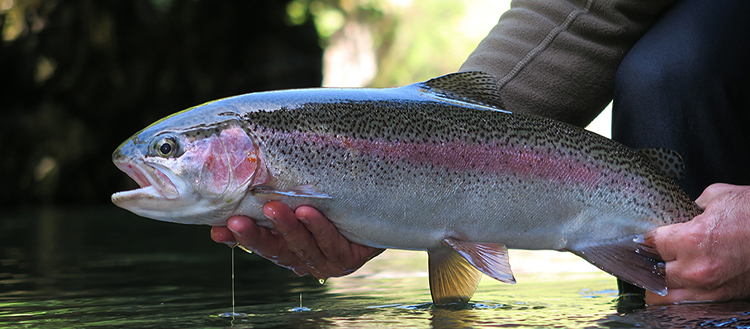Non-native species are also beneficial to the ecosystem
A team led by UNIGE and Brown University makes the case for reevaluating maligned non-native species.

A non-native species, the brown trout is, for example, highly valued by New Zealanders who have established new environmental regulations to protect the species in their waters. © Adobe Stock
Awareness of non-native species - often called ‘‘invasive’’ - has vastly increased over the past fifty years, to the point where anyone with green conscience has heard of them and their negative effects, whether it is the zebra mussel or ragweed. However, the contribution of these species can also be positive, as some earthworms help to improve the processes involved in organic farming. This is the finding of a study conducted by a team of researchers from Brown University in the United States and University of Geneva (UNIGE) in Switzerland. These results are published in the journal Trends in Ecology and Evolution.
Within the scientific literature, long-standing biases against non-native species have clouded the scientific process and hindered public understanding. In a recent review article published in the journal Trends in Ecology and Evolution, an international team including researchers from Brown University, the University of Geneva (UNIGE) and the University of Washington points out that the majority of studies on these species focus on their negative consequences. In this new paper, the scientists propose to shift the focus to also consider the potential benefits of non-native species for a more balanced discussion.
‘‘Positive impacts of non-native species are often explained as serendipitous surprises — the sort of thing that people might expect to happen every once in a while, in special circumstances,’’ says Dov Sax, a professor in the Department of Ecology, Evolution and Organismal Biology at Brown University. ‘‘Our new paper argues that the positive impacts of non-native species are neither unexpected nor rare, but instead common, important and often of large magnitude.’’
Good for people and nature
The study borrows from a recent framework developed by IPBES, an international platform for the assessment of biodiversity and its ecosystem services, which examines the benefits of biodiversity for people and nature, and applies it to non-native species, showing the diverse, frequent and important ways that non-native species provide positive value for people and nature. “We want to provide a framework for the way that scientists can think about non-native species constructively going forward and explicitly document their benefits,” Sax said. “It’s only then that we’ll be able to accurately and fully compare and contrast them in order to perform the kind of cost-benefit analyses that can be truly helpful in making policy decisions.”
The authors acknowledge that some non-native species, such as introduced pathogens and agricultural pests, cause indisputably large net costs. But they note that most domesticated non-native species - including food like wheat and tomatoes, fibres such as cotton and wool, and pets including dogs and goldfish - provide large net benefits to human societies. Scientists have focused their review on species that are not directly managed by people - so-called ‘‘wild’’ or ‘‘naturalised’’ species - noting that many of these simultaneously provide both costs and benefits for people and nature.
The benefits of earthworms on organic farming
The study cites earthworms as an example of a non-native species with underappreciated benefits. While they can negatively change forest ecosystems, they can also augment organic agriculture: a meta-analysis has shown that their presence can lead to a 25% increase in agricultural productivity. The resulting decrease in food cost and increased ability to feed people is a direct economic benefit caused by earthworms, including in areas where they are non-native.
The study also highlights the unexpected benefits of another non-native species - brown trout. Looking at New Zealand as an example, it shows that most of the non-native species that have invaded the country have negative consequences, and residents therefore focus on eradicating them. Yet the nation has effectively embraced brown trout: New Zealanders value the nutritional and recreational benefits of fishing it so much that they have established new environmental regulations to protect the species within their waters.
‘‘The framework we posit provides a useful topology for considering the diverse array of ways that non-natives provide value, and we use it here to illustrate representative, but not exhaustive, examples of these values from diverse ecosystems and regions,’’ says Martin Schlaepfer, a lecturer at the Institute of Environmental Sciences at UNIGE.
A new framework for thinking
The study recommends using the IPBES framework, which describes the many ways in which nature can be valued, and applying it to non-native species. ‘‘How people relate to nature, to the intrinsic value of nature, to the ecosystem services, to the provisioning of resources — these are all things that we value in native species, and there are also ways to see that non-native species are contributing to these benefits, too’’, explains Martin Schlaepfer.
For example, non-native species can be a leading cause of species extinction but also contribute, through their own migration, to regional biodiversity by increasing species richness, including in Switzerland. Introduced mussel species in Swiss lakes, for example, can alter available nutrients while increasing water clarity. ‘‘We argue that long-standing biases against non-native species within the literature have clouded the scientific process and hampered policy advances and sound public understanding. Future research should consider both costs and benefits of non-native species’’, concludes Martin Schlaepfer.
